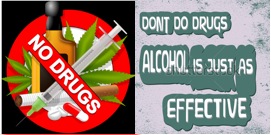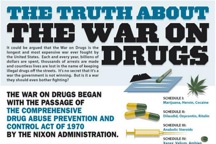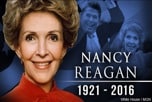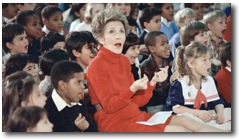On Sunday, March 6, 2016, former First Lady Nancy Reagan passed away at the age of 94, after suffering congestive heart failure. Mrs. Reagan will always be remembered for her “Just Say No” ad campaign designed to prevent teenagers from using drugs, which also became emblematic of her husband’s War on Drugs.
“Just Say No” was the cultural, family-oriented prong of the White House’s assault on America’s drug problem. The phrase first emerged when Nancy was visiting Longfellow Elementary School in Oakland, California in 1982 and was asked by a schoolgirl what to do if she was offered drugs. The former first lady responded by saying, “just say no.” Following the response, “Just Say No” club organizations within schools and school-run anti-drug programs soon became common places for young people to make pacts not to experiment with drugs. In spite of both the Reagans’ noble work, and every Presidential administration thereafter, it’s safe to say America is still losing the War on Drugs with no real solution in sight.
The Opioid Problem
Let’s look at one of the problems. Opioids are a class of drugs that include the illicit drug heroin, as well as prescription pain relievers oxycodone, hydrocodone, codeine, morphine, fentanyl and others. After years of looking the other way, it’s finally safe to say the “heroin epidemic” has grown largely out of dependence on legal opioid painkillers and has spread to white, urban, suburban and rural areas. Nationally, 125 people a day die from overdosing on heroin and painkillers, and many more are revived from a near-death experience. The police in Upper Darby, Pennsylvania have even posted a video of another man shooting heroin on a public bus, and then being revived by Narcan, which reverses the effects of a heroin overdose. With Narcan now being sold in your local pharmacy, addicts buy the product to have on hand in case they overdose. This is smart and sick at the same time.
According to the American Society of Addiction Medicine, of the 21.5 million Americans 12 or older who had a substance use disorder in 2014, 1.9 million had a substance use disorder involving prescription pain relievers and 586,000 had a substance use disorder involving heroin. It’s estimated 23 percent of individuals who use heroin develop opioid addiction. Drug overdose is the leading cause of accidental death in the U.S. with 47,055 lethal drug overdoses in 2014. Opioid addiction is driving this epidemic, with 18,893 overdose deaths related to prescription pain relievers and 10,574 overdose deaths related to heroin in 2014.
Ninety-four percent of respondents in a 2014 survey of people in treatment for opioid addiction said they chose to use heroin because prescription opioids were “far more expensive” and harder to obtain. In 2014, an estimated 28,000 adolescents had used heroin in the past year and an estimated 16,000 were current heroin users. Additionally, an estimated 18,000 adolescents had a heroin use disorder in 2014. People often share their unused pain relievers, unaware of the dangers of non-medical opioid use. Most adolescents who misuse prescription pain relievers are given them for free by a friend or relative. The prescribing rates for prescription opioids among adolescents and young adults nearly doubled from 1994 to 2007. This is where the real problem exists, but like alcohol—it’s legal.
Women And Prescription Drug Overdose
Women are more likely to have chronic pain, be prescribed prescription pain relievers, be given higher doses, and use them for longer periods than men. They may become dependent on prescription pain relievers more quickly than men. Forty eight thousand women died of prescription pain reliever overdoses between 1999 and 2010. Prescription pain reliever overdose deaths among women increased more than 400 percent from 1999 to 2010 compared to 237 percent among men. Heroin overdose deaths among women have tripled in the last few years. From 2010 through 2013 female heroin overdoses increased from 0.4 to 1.2 per 100,000. Far too many women are in unstable relationships, out of school, with children, and/or unemployed with no support network. The stress behind this is enough to make a person travel down that dark road of substance abuse.
White Men Dying
A New York Times analysis of death certificates has found that young white adults are dying from drug overdoses at levels not seen since the end of the AIDS epidemic more than two decades ago—a turn of fortune that stands in sharp contrast to falling death rates for young Blacks. The rising death rates for those young white adults, ages 25 to 34, make them the first generation since the Vietnam War years of the mid-1960s to experience higher death rates in early adulthood than the generation that preceded it. Again, there is no solution in sight as our elected officials and their War on Drugs continue to fail our children.

“That is startling,” Dr. Wilson Compton, the deputy director of the National Institute on Drug Abuse, says. “Those are tremendous increases.”
Rising rates of overdose deaths and suicide appear to have erased the benefits from advances in medical treatment for most age groups of whites. Death rates for drug overdoses and suicides “are running counter to those of chronic diseases,” like heart disease, Ian Rockett, an epidemiologist at West Virginia University, said. According to Dr. Andrew Kolodny, a drug abuse expert, one of the reasons some say that Blacks appear to have been spared the worst of the narcotic epidemic is that doctors are much more reluctant to prescribe painkillers to minority patients, worrying they might sell them or become addicted. Well, maybe they can begin to share some of those same concerns for their white patients.
Failed War On Drugs No One Wants To Talk About
Drug abuse, of both illegal drugs like heroin and prescription painkillers, has become a part of the American political discourse as never before in this country, with some presidential candidates, including Jeb Bush and Carly Fiorina, telling stories of addiction in their own families. Telling stories is cool, but using your political influence to come up with a better plan to replace the failed “War on Drugs” would go a lot further in the eyes of young voters and their parents. In America, we have been taught to be winners so how much longer will we continue to fund a losing policy? Where are the bright minds when our children need them?

As a Nation its sad to say but our elected officials are still not SMART enough to Win the the War on Drugs. Does Donald Trump have a Solution?
“Poverty and stress, for example, are risk factors for misuse of prescription narcotics,” Dr. Hayward says.
Eileen Crimmins, a professor of gerontology at the University of Southern California, said the causes of death in these younger people were largely social: “violence and drinking and taking drugs.” Her research shows social problems are concentrated in the lower education group. Data says if you can’t read by the 4th grade, you are headed down the road to prison.
With heroin cheap and widely available on city streets nationwide, users are making their buys and shooting up as soon as they can, often in public places. Police are routinely finding drug users unconscious or dead: in cars, in the bathrooms of fast-food restaurants, on mass transit, and in parks, hospitals and libraries. Nancy Reagan first became involved with the War on Drugs during a campaign trip in 1980 to Daytop Village, New York. She recalls feeling impressed by a need to educate the youth about drugs and drug abuse. Upon her husband’s election to the presidency, she returned to Daytop Village and outlined how she wished to help educate our children, youth and young adults about the dangers of substance abuse, heroin and illegal drugs.
One of the ideas being touted around to quell the growing crisis is using the power of film and celebrities to create a message of impact to young citizens on prevention, education and awareness. There is talk about making a film based on the book Forgiving Kevin, a true story about the trials and tribulations of a father who lost his son to heroin. To support the project, a documentary on the crisis and national public relations campaign is being created with the help of some of the top executives, artists, athletes, and actors in the world, each with an invested interest to get behind a real movement to finally end the epidemic.



